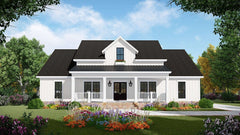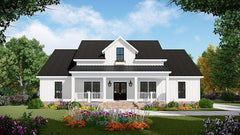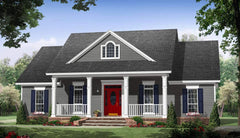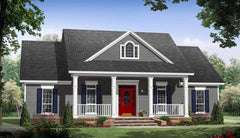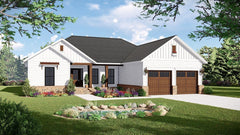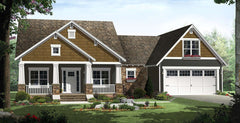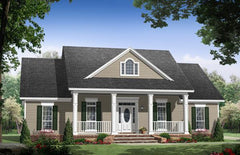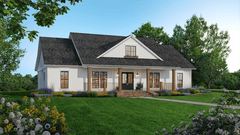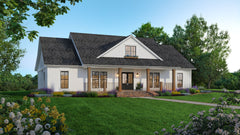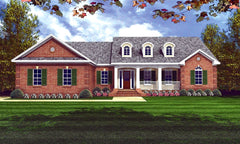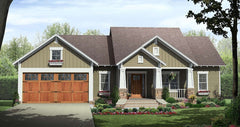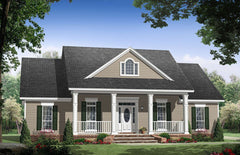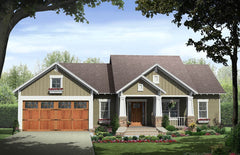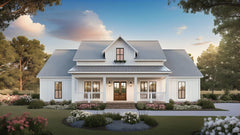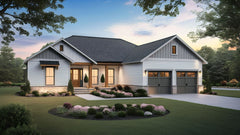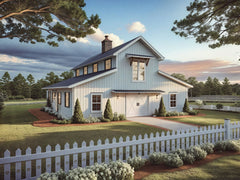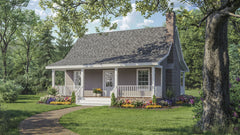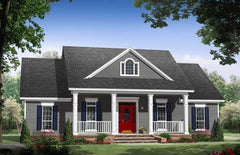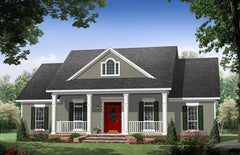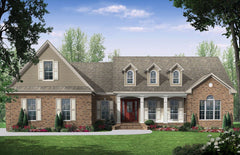

Transcript of Build Your Dream Home Podcast - Episode 13:
Mark Mathis:
This is a Build Your Dream Home Podcast with Mark Mathis. Episode 13.
Announcer:
Always wanted to build your dream house, but not sure where to start? You're in the right place. Welcome to the Build Your Dream Home Podcast, where experts in the industry share their knowledge and help you to be one step closer to building your dream home. And here's your host, Mark Mathis.
Mark Mathis:
Hey everybody, this Mark Mathis with House Plan Gallery and the Build Your Dream Home Podcast. I really appreciate you taking the time out of your busy schedule. I know that you've got all kinds of different things that you could be doing right now and I'm glad that you're listening to us. We appreciate you.
We appreciate all the positive feedback that we've been receiving from a lot of you on the quality of the podcast and information, and I'm just so happy that it's helpful to you whether or not you choose one of our house plans or not, it really doesn't matter. All I'm trying to do is give you the information that you need to know.
So, if you're looking to build a dream home for your family, I want you to do that because I don't want you to be scared about the process. I don't want you to worry about the process at all. It's very clear and understandable, hopefully in the way that we're describing it. And it will give you all the information that you need to really get started. So again, thank you.
Depending on when you're listening to this, I can just tell you from our side, we've got three kids and getting them back into school. My oldest one is in Cub Scouts and then we're also doing basketball and all kinds of other stuff. So if you have kids, you'll know how busy this time of year is. And I'm not really sure I'm ready for it just yet. But anyway, we've got a Cub Scout camping trip coming up.
Growing up, we lived down in the country, we grew up on a farm and we had woods and everything and that's where we played. But I was never really into camping out. I always would go out in the yard and stay till about 9:00 or 9:30 maybe with my buddies. And then we'd say, enough of this. We go inside and we'd "camp out" I'm doing air quotes right now, in the living room or whatever. And that was basically it.
Well, my son Jake is really into this camping out stuff and it's not like camping. If I were to go out there and camp, we'd probably be eaten by wolves and forget to bring food and anything like that. When we go out there with these Cubs Scout guys, some of these adults are way into this and so they have all the portable camping, you know cooking equipment, everything's propane powered. They have all the gear set up in their trailer, they know how to do everything and you just basically set up your tent and then they call you for dinner and then you go around and do different activities.
And I love the outdoors. That's my favorite thing in the world is being outdoors in the woods. And it's just a really cool thing to see my young son gravitate towards that and get the same joy out of it that I did, but I will probably never taken him camping by myself, but just going out there with these guys that know exactly what they're doing and handle all the food and all that kind of stuff. It makes it really enjoyable. So hopefully that's enough of a tangent for this episode.
I want to send a quick shout-out to someone who's gone on to iTunes and been kind enough to leave us a five-star review and leave us a star rating as well. So, this is MCSamMC and the title is Great Information. Again, it's a five-star review and he says, "Not only is the information top-notch, I liked that all the content is backed up by industry professionals and there are sites given where we can go to find out more information for ourselves. Mark has a very relaxed manner, which makes it feel more like a conversation between friends and I can't wait to hear more." I really appreciate you going out there and leaving that a review MCSamMC and if you'll send me an email at mark@houseplangallery.com, I've got a special gift for you.
And I encourage everyone out there if you would be so kind, if you liked this podcast, if you can go out to iTunes, checking out, subscribe to it first so you'll get all the new episodes as they come out. But also leave us a star rating and a review out there because it helps us to increase our rankings on iTunes that turns into being found by more people. And so again, what we're trying to do is just help everyone become more knowledgeable and comfortable with the whole house building process. And so we're trying to give that information to you. So if you could do that, I would really, really appreciate it. Okay. And now before we get started, let's listen to this message from our sponsors.
Announcer:
Looking for the latest cool home ideas and pictures of awesome new house features that you can include in your new home? Check out our Facebook page at www.houseplangallery.com/facebook, where every single week we'll share new home my ideas you will fall in love with.
Mark Mathis:
Okay now, this episode is all about things to include absolutely when you're building your new home. Now there's many things as you go through the building process that you may not have enough money to do exactly the ideal perfect scenario you know that you'd like to have long term. However, there's some things that you need to do up front and spend a little bit more money and you're going to be extremely happy with the returns.
And these are some things that I personally have found with a house that we're living in now. But also I've heard time and time again from people who build their homes and they really regret not doing this up front. So I want to give you this information so you know before you build your house to plan for these items to actually be done.
So, number one, you need to realize that your current needs aren't always going to be your future needs. So keep that in mind when you're building for today, that might not be what you want or need in the future.
So item number two, consider resale features, things that might not be important to you. One day you're going to look to sell your house or your kids are going to look to sell your house. Basically that house will go out of your family in some way typically. And so you will make sure that the house that you've built is going to be one that's resellable and that it has all the features and amenities that people are going to expect both today and in the future.
So number one, and this is extremely important. I'm a technology guy and I love fast Internet. I love technology and computers and everything. And we have them all over the house and my kids do too. So you want to add Cat5 or Cat6 hardwired cables in every room.
So everybody says, you know with wireless nowadays, why do we need to have hard plugs coming out of the wall to actually connect to the internet and the home network? Well, the reason is speed and reliability, those are the two items. They don't go down nearly as much. The speed is going to be much, much faster. It gives you flexibility with you can have some hardwired desktop, computers and maybe your home office locations. Also, with TiVos and your DVRs today, they all require Internet connections and hardwired connections are always going to be more reliable. You're going to get a more reliable feed and speed as well.
So definitely every single room in your house, it doesn't really cost that much more to actually drop that when you're dropping in your coaxial cable for your cable or your phone cords or anything like that. So definitely hardwire all of your rooms, every single room except for your bathrooms and your closets. That's the only two places I wouldn't add plugs. And in some, I may actually add more than one. For example in home offices and things like that. So hardwire with Cat5 or Cat6 ethernet cables.
Number two you want to wire for surround sound and security system, so you definitely want to have a security system at some point. Just have your electrician add all that wiring behind the walls initially so that won't have to be snaked down and your costs go up when you're retrofitting and after the fact.
Now for surround sound, even if you don't ever intend on having a surround sound system, you want to wire your house so that it can be managed, have sound in different rooms be managed from one central location, so definitely do that as well. It doesn't cost much more to do that, but future home buyers will definitely appreciate that and you may appreciate it down the road if you choose to install that as well.
Next, you want to install a power plug. So electrical plug, a Cat5 or six cable and coaxial cable in locations on the wall where you're going to potentially hang flat-panel screen. So everyone today pretty much hangs their flat-panel TV on the wall, especially to save on space if you're living in a smaller house it’s definitely the way to go.
And one of the most frustrating things for us, we have our TV over our fireplace and you know there wasn't any plugs there obviously. There wasn't any ethernet cables, there wasn't any coaxial cables, there wasn't a power plug, there wasn't a HDMI cable outlet so we could actually just plug into that and we had to have all that stuff retrofitted and added in. It made a big mess. Now we have cables that are real tight going into a cabinet and it's just not ideal situation.
So if there's somewhere, there's obviously the place where you're going to put a flat-panel TV, then definitely run all that stuff so it's there and you can add that later on if you don't do it initially. If you don't like it and you don't use it, all you got to do is put a mirror or maybe a big picture or something that over the hole but have that there so they'll definitely be accessible when the time comes that you or someone who purchases your house will want to actually add that in. So that's a big pet peeve, not having those plugs actually in there.
Next, add more electrical outlets than you think you're going to need. So you might think two electrical outlets is plenty for a room. In this day and age with all the electronic gadgets and everything that attaches to electrical plugs, you'll definitely want to have, I would say at least minimum four in each room. And ideally you want to have one about every four feet, three or four feet of wall space that you have. You're going to have specialized ones again for locations where you're going to have your TV and things like that. And maybe if you have anything in the ceiling that actually needs a plug, you'll need to look at that as well. So add more than you think you're going to need. Have that run behind the walls by the electrician. It doesn't cost that much more at all, but just make sure that you have it.
Next is build extra storage inside. So you may think that the size of closets that you have in your new home are going to fit you forever, but they will not. If you live in any house over a couple of years, you're going to need more storage space. And so if you can build that into the floor plan and utilize spaces otherwise wasted, maybe underneath stairs. We have a closet underneath our stairs going up to the bonus room that we put all kinds of stuff in there, like our luggage, which is very big and bulky. We really wouldn't have another place to put it if we didn't put it there. So think about storage as you're building out the house. It's very easy to build in additional storage spaces and then you can have that all painted and sheet rock at the same time as you're doing the rest of the house.
Next, you want to put boards down on the attic floors. I cannot tell you how many people fall through the attic ceiling and sometimes they fall all the way down to the floor and get hurt. But in most cases what happens we find is that they pushed their foot through the Sheetrock and make a big hole and you can never repair that where it looks perfect again. So take the time and spend a little bit of money and go and get you some nice quarter-inch or half-inch plywood and put those over those rafters in the attic so when you're stepping on, going through your attic to actually put stuff up there and get it out of your way, you're not falling through there and your wife is safe, you're safe, and your kids are safe. Definitely don't do it later on because you'll never do it. There's never a good time to tote six or eight-foot long sheets of flour upstairs and then get in that hot attic in the summertime in South Louisiana and nail that down. So definitely do that up front where you can.
Next, it's ideal to have a flex space in your house for changing needs. For example, one of our most popular flex spaces is generally in an area off the front foyer and is attached to the living area or great room. And many people use that as a traditional dining room. However, younger families, many times use that as a playroom, as a home office, as an arts and crafts room, as a good room for having kids to be able get all their homework done.
Ours right now is a playroom. We'll never use a dining room really because we don't have formal dining room parties, and we have all of our get-togethers in our kitchen area that also has a large table in there. So what we use it for is a playroom right now, while the kids are young. This is going to evolve shortly into an area for them to do their homework and have all their stuff out of the way. And then long term it's going to turn into probably up more of a home office type set-up.
And we have two walls in there or four walls really, but two of the walls have French doors that can be enclosed. We also use it as a guest room area when we have overnight guests that aren't able to sleep in the main guest room because there's somebody in there. So we're going to put a sleeper bed in there or something like that.
So just having the options to, they have spray foam insulation, that's a very good product. However, it's much more expensive than traditional rolled-in insulation, which you can get for a very nominal price. But get the highest quality insulation that you can, that you feel comfortable in spending because once it's in the wall, it's basically in there. And if you're planning on living in the house for a very long time, that's going to help tremendously with your electricity bills.
And so this last item is something that's very near and dear to my heart and that is to have at least one home office in your house. And by one, I really mean two. Ideally one for you and your wife. That is totally separate where you have your own space, where you can put your own stuff, you can set up your room exactly how you want it. Ideally it's in a quiet location. And this might just be a really deep closet that you retrofit into a home office as well and you have everything closed away. Whatever it is, in this day and age, every person in the house, the adults need their own space that I like to say a home office. It can be a media room, it can be a craft room, it can be whatever it is that makes sense for you.
For me, that's a home office. That's where I like to keep my guitars and my computers and my printers and set-up and all that where my kids don't get on in and mess up my settings and everything like that. But it gives you your very own space and I think that's important to maintain a happy relationship. So definitely think about that. That might be in a bonus room, that might be in a flex space, that might be again, in a hall closet that's retrofitted to have a small desk in there where you can hide everything away. That can be a little nook off of your mudroom that is used for storing your bills and things like that. But ideally you would have a room, whatever the size is that would be able to be enclosed and that you could have for your own personal needs, whether it be a home office or whatever.
So again, I hope this was a very helpful episode for you. I've learned a lot myself just in preparing for this, just based on taking the information that we hear every day from our clients and that we hear through our different social media channels, like on our Facebook pages and things like that, that these are items that are really important and very easy to do before the house is built or as it's being built, but they become increasingly more difficult after the fact to retrofit because you're talking about cutting walls, removing Sheetrock, patching Sheetrock, repainting and you're living in the house. I mean just going through this process where we had the flood in our house and living in that misery to remodel the house basically from floor to ceiling has not been fun. I can tell you 100% is not been fun and I would never ever recommend remodeling the house while you're still living in it, if it's any size of a remodel whatsoever.
So with that, if you have any questions, be sure to leave those on our show notes page at www.houseplangallery.com/blogs/news/podcast-13-top-items-that-most-people-forget and on there we'll have links to all the resources that we've talked about in this episode and we'll be able to see your questions and comments if we can ever be of any service to you. We appreciate you so much and we're always here for you. Whatever you need, just give us a call or email us at sales@houseplangallery.com and we'll be glad to help. So with that, we'll end this episode and until next time, I hope you have a blessed day.
Announcer:
Are you excited about building your new dream home and want instant access to even more bonuses? Then just head over to www.houseplangallery.com/dreamhome to claim our new dream home success kit, which includes thousands of dollars’ worth of additional videos, training, tools, secret online resources, and much more. Again, that website is www.houseplangallery.com/dreamhome. It is completely free to join. So what are you waiting for?



